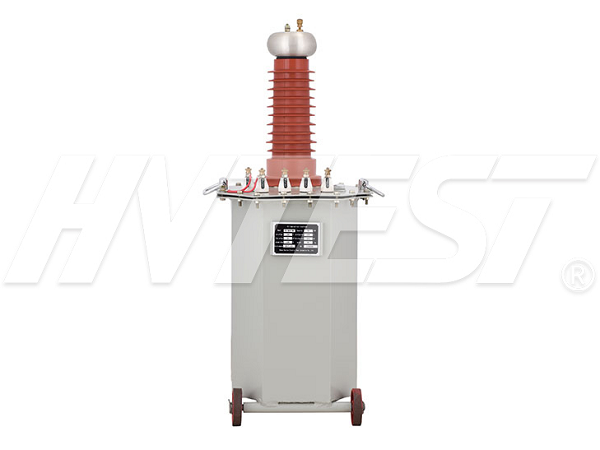Detection Technology
Failure Analysis of High Voltage Test Transformer
When the test transformer is in normal operation, it will emit a continuous and even "humming" sound. If the sound produced is uneven or there are other special noises, it should be regarded as abnormal operation of the transformer, and the fault can be found out according to the different sound and processed in time. The main faults are as follows:
The power grid has overvoltage. When single-phase grounding or electromagnetic resonance occurs in the power grid, the sound of the transformer is sharper than usual. When this happens, it can be combined with the instructions of the voltmeter to make a comprehensive judgment.
Test the transformer for overload operation. The load changes greatly, and due to the effect of harmonics, an intermittent sound of "wow" or "cackling" occurs in the transformer instantaneously, and the pointer of the monitoring and measuring instrument swings, and the pitch is high and the volume is loud.
The transformer clips or screws are loose. When the sound is louder than usual and there is obvious noise, but there is no obvious abnormality in the current and voltage, it may be that the internal clamp or the screw that presses the iron core is loose, causing the silicon steel sheet to vibrate.
Partial discharge of transformer. If the transformer's drop-out fuse or tap switch is in poor contact, there will be a "creaking" discharge sound; if the transformer's transformer bushing is dirty, the surface enamel is peeling off or there are cracks, a "hissing" sound can be heard ; If there is a partial discharge or poor electrical connection inside the transformer, a "squeak" or "crack" sound will be emitted, and this sound will vary with the distance from the fault. At this time, the transformer should be deactivated immediately.
The transformer winding is short-circuited. The sound is mixed with the sound of water boiling, and the temperature changes sharply, and the oil level rises. It should be judged that the transformer winding has a short-circuit fault. In severe cases, there will be a huge roar, and a fire may follow. At this time, the transformer should be stopped immediately for inspection.
Test the flashover discharge of the transformer housing. This sound will appear when the high voltage of the transformer winding causes the outgoing wires to flashover and discharge to each other or to the shell. At this time, the transformer should be shut down and checked.
Odor, abnormal color
The rupture of the explosion-proof membrane of the explosion-proof tube: the rupture of the explosion-proof membrane of the explosion-proof tube will cause water and moisture to enter the transformer, resulting in the emulsification of the insulating oil and the reduction of the insulation strength of the transformer.
Bushing flashover discharge, bushing flashover discharge will cause heat generation, aging, insulation damage and even explosion.
Overheating of the lead (terminal) and line card causes abnormality; the fastening part of the sleeve terminal is loose or the nose of the lead is slippery, etc., the contact surface is seriously oxidized, which makes the contact overheated, the color darkens and the surface coating is also Destroyed.
Sleeve fouling causes abnormality; fouling of the sleeve produces corona, flashover will produce ozone smell, and the burning of cooling fan and oil pump will give off a burnt smell.
In addition, excessive moisture absorption, damaged gaskets, and too much water entering the oil chamber can cause discoloration of the moisture absorbent.
Abnormal oil temperature
It is found that under normal conditions, the oil temperature is higher than usual by more than 10 degrees Celsius or the load remains unchanged while the temperature continues to rise (under the normal operation of the cooling device), it can be judged that there is an abnormality inside the transformer. Mainly:
An internal fault caused an abnormal temperature. Its internal faults, such as short circuit between windings or layers, discharge of the coil to the enclosure, heating of the internal lead joints, multi-point grounding of the iron core, increase the eddy current and overheat, and the leakage of magnetic flux such as zero-sequence unbalanced current forms a loop with the iron tank to generate heat. Factors such as the abnormal temperature of the transformer. When these situations occur, it will be accompanied by gas or differential protection actions. When the fault is serious, the explosion-proof pipe or the pressure release valve may be injected with oil. At this time, the transformer should be stopped for maintenance immediately.
Abnormal temperature caused by abnormal operation of the cooler. The cooler is operating abnormally or malfunctioning, such as the submersible pump is out of operation, the fan is damaged, the radiator pipe is fouled, the cooling effect is not good, the radiator valve is not opened, the thermometer indicator malfunctions and many other factors cause the temperature to rise, respond to the cooler system Carry out maintenance and flushing to improve its cooling effect.
Transformer fault detection and troubleshooting | 2021/7/23 | reading678time AC and DC oil-immersed test transformer details | 2021/7/22 | reading674time return


